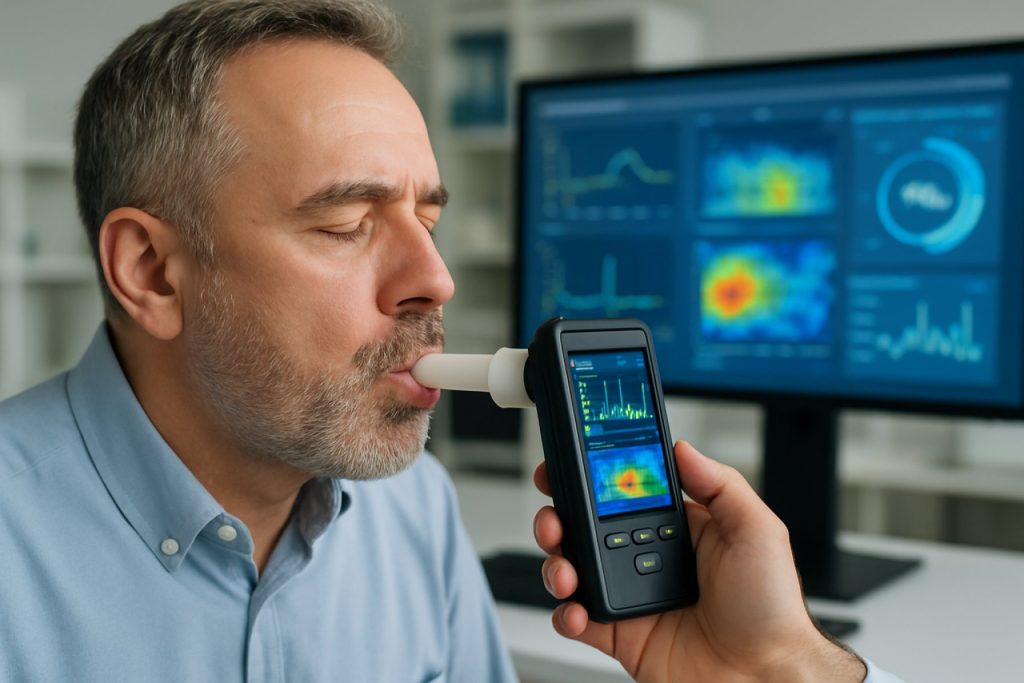
Exhaled Breath Biomarker Analytics Market Report 2025: In-Depth Analysis of Growth Drivers, Technology Innovations, and Global Opportunities. Explore Key Trends, Forecasts, and Strategic Insights for Industry Stakeholders.
- Executive Summary & Market Overview
- Key Market Drivers and Restraints
- Technology Trends in Exhaled Breath Biomarker Analytics
- Competitive Landscape and Leading Players
- Market Size, Share, and Growth Forecasts (2025–2030)
- Regional Analysis: North America, Europe, Asia-Pacific, and Rest of World
- Emerging Applications and Use Cases
- Challenges, Risks, and Regulatory Considerations
- Opportunities and Strategic Recommendations
- Future Outlook: Innovations and Market Evolution
- Sources & References
Executive Summary & Market Overview
Exhaled breath biomarker analytics is an emerging field within non-invasive diagnostics, leveraging advanced sensor technologies and data analytics to detect volatile organic compounds (VOCs) and other biomarkers present in human breath. These biomarkers can provide real-time insights into metabolic, infectious, and oncological diseases, offering a promising alternative to traditional blood-based or imaging diagnostics. The global market for exhaled breath biomarker analytics is poised for significant growth in 2025, driven by increasing demand for rapid, non-invasive diagnostic tools, advancements in sensor miniaturization, and the integration of artificial intelligence (AI) for enhanced data interpretation.
According to Grand View Research, the global breath analyzer market was valued at USD 2.6 billion in 2023 and is projected to expand at a compound annual growth rate (CAGR) of over 15% through 2030. While much of this market is currently dominated by alcohol and drug testing, the medical segment—particularly disease diagnostics—is expected to see the fastest growth. The increasing prevalence of chronic diseases such as asthma, chronic obstructive pulmonary disease (COPD), and lung cancer, alongside the need for early detection and monitoring, is fueling adoption in clinical settings.
Key industry players, including Owlet, Inc., Thermo Fisher Scientific Inc., and Siemens Healthineers, are investing in research and development to enhance the sensitivity and specificity of breath-based diagnostic platforms. Startups such as Breathomix and Owlytics Healthcare are also contributing to innovation, particularly in the integration of cloud-based analytics and machine learning algorithms.
- Regulatory momentum is building, with the U.S. Food and Drug Administration (FDA) granting breakthrough device designations to several breath-based diagnostic tools in recent years (U.S. Food and Drug Administration).
- Europe and Asia-Pacific are emerging as key regions for market expansion, supported by government initiatives to promote early disease detection and personalized medicine (European Commission).
- Challenges remain, including standardization of biomarker panels, reimbursement pathways, and clinical validation across diverse populations.
In summary, exhaled breath biomarker analytics is transitioning from research to real-world clinical and consumer applications, with 2025 expected to mark a pivotal year for commercialization, regulatory approvals, and broader healthcare integration.
Key Market Drivers and Restraints
The exhaled breath biomarker analytics market is poised for significant growth in 2025, driven by a convergence of technological advancements, rising prevalence of respiratory and metabolic diseases, and increasing demand for non-invasive diagnostic tools. Key market drivers include:
- Technological Innovation: Rapid advancements in sensor technologies, such as mass spectrometry, gas chromatography, and electronic noses, have enhanced the sensitivity and specificity of exhaled breath analysis. These innovations enable the detection of volatile organic compounds (VOCs) at trace levels, facilitating early disease diagnosis and monitoring (MarketsandMarkets).
- Rising Disease Burden: The global increase in respiratory diseases (e.g., asthma, COPD), metabolic disorders (e.g., diabetes), and infectious diseases (e.g., COVID-19) is fueling demand for rapid, non-invasive diagnostic solutions. Exhaled breath biomarker analytics offer a patient-friendly alternative to blood tests and imaging, supporting early intervention and personalized medicine (World Health Organization).
- Regulatory Support and Research Funding: Government initiatives and funding for biomarker research, particularly in the US and Europe, are accelerating the development and commercialization of breath-based diagnostic platforms. Regulatory agencies are increasingly recognizing the clinical utility of breath biomarkers, streamlining approval pathways for innovative devices (U.S. Food and Drug Administration).
- Growing Adoption in Clinical Trials: Pharmaceutical companies are integrating exhaled breath analysis into clinical trials for drug efficacy and safety monitoring, further validating the technology’s utility and expanding its market potential (Pharmaceutical Research and Manufacturers of America).
However, several restraints temper market expansion:
- Standardization Challenges: Lack of standardized protocols for sample collection, analysis, and interpretation hampers cross-study comparability and clinical adoption (National Institutes of Health).
- High Initial Costs: Advanced analytical instruments and the need for skilled personnel contribute to high setup and operational costs, limiting adoption in resource-constrained settings.
- Regulatory and Reimbursement Hurdles: Unclear regulatory pathways and limited reimbursement for breath-based diagnostics in many regions pose barriers to widespread clinical integration.
Overall, while the exhaled breath biomarker analytics market faces notable challenges, robust drivers are expected to sustain its growth trajectory through 2025.
Technology Trends in Exhaled Breath Biomarker Analytics
Exhaled breath biomarker analytics is rapidly evolving, driven by advances in sensor technology, data analytics, and miniaturization. In 2025, several key technology trends are shaping the landscape of this non-invasive diagnostic field, with a focus on improving sensitivity, specificity, and real-time analysis capabilities.
- Integration of Artificial Intelligence (AI) and Machine Learning (ML): AI and ML algorithms are increasingly being embedded into breath analysis platforms to enhance pattern recognition and biomarker identification. These technologies enable the processing of complex datasets, facilitating the differentiation of disease-specific volatile organic compounds (VOCs) from background noise. Companies such as Owkin and DeepMind are actively developing AI-driven models for medical diagnostics, including breathomics.
- Advancements in Sensor Technology: The development of highly sensitive nanomaterial-based sensors, such as graphene and metal oxide semiconductors, is enabling the detection of trace-level biomarkers in exhaled breath. These sensors offer rapid response times and can be integrated into portable devices, supporting point-of-care applications. Siemens Healthineers and Philips are among the companies investing in next-generation sensor platforms for breath analysis.
- Miniaturization and Wearable Devices: The trend toward miniaturization is leading to the development of compact, user-friendly breath analyzers and even wearable devices. These innovations are making continuous and remote monitoring feasible, expanding the potential for early disease detection and personalized health management. Startups like Breathomix are pioneering portable breath analysis solutions.
- Cloud Connectivity and Data Integration: Cloud-based platforms are being leveraged to aggregate, store, and analyze breath biomarker data from multiple sources. This connectivity supports large-scale studies, real-time monitoring, and integration with electronic health records (EHRs), enhancing clinical decision-making. Microsoft and Google Cloud Healthcare are providing infrastructure for secure data management in breathomics.
- Multiplexed Detection and Multi-Omics Approaches: New analytical platforms are capable of simultaneously detecting multiple biomarkers, increasing diagnostic accuracy. Integration with other omics data (e.g., genomics, proteomics) is also being explored to provide a more comprehensive view of patient health.
These technology trends are collectively accelerating the adoption of exhaled breath biomarker analytics in clinical and research settings, with the potential to transform early disease detection, monitoring, and personalized medicine by 2025.
Competitive Landscape and Leading Players
The competitive landscape of the exhaled breath biomarker analytics market in 2025 is characterized by a dynamic mix of established medical device manufacturers, innovative startups, and academic-industry collaborations. The sector is witnessing rapid technological advancements, particularly in sensor miniaturization, artificial intelligence (AI)-driven data analysis, and non-invasive diagnostic platforms. These innovations are intensifying competition and accelerating the pace of product development and regulatory approvals.
Key players dominating the market include Owlstone Medical, renowned for its Breath Biopsy® platform, which leverages volatile organic compound (VOC) analysis for early disease detection, including cancer and respiratory illnesses. Menssana Research is another significant player, focusing on breath-based diagnostics for infectious diseases and metabolic disorders, with several products in advanced clinical trials. Breathomix has gained traction with its SpiroNose® technology, which utilizes cloud-connected eNose devices and machine learning algorithms for real-time disease profiling.
Emerging companies such as Deep Breathe and BreatheSuite are leveraging AI and digital health platforms to enhance the accuracy and scalability of breath biomarker analytics. These firms are attracting significant venture capital and forming strategic partnerships with pharmaceutical companies and healthcare providers to accelerate commercialization.
The market is also shaped by collaborations between industry and academia, with institutions like Imperial College London and Massachusetts Institute of Technology (MIT) contributing to foundational research and clinical validation studies. Such partnerships are crucial for overcoming regulatory hurdles and establishing clinical utility.
- Product Differentiation: Companies are competing on the basis of sensitivity, specificity, ease of use, and integration with electronic health records (EHRs).
- Regulatory Milestones: Achieving CE marking and FDA clearance remains a key differentiator, with Owlstone Medical and Breathomix making notable progress in this area.
- Geographic Expansion: Leading players are expanding into North America, Europe, and Asia-Pacific, targeting both hospital and point-of-care settings.
Overall, the competitive landscape in 2025 is marked by rapid innovation, strategic alliances, and a race to achieve clinical adoption and regulatory approval, positioning exhaled breath biomarker analytics as a transformative segment within non-invasive diagnostics.
Market Size, Share, and Growth Forecasts (2025–2030)
The global exhaled breath biomarker analytics market is poised for significant expansion in 2025, driven by technological advancements, increasing prevalence of respiratory and metabolic diseases, and a growing emphasis on non-invasive diagnostic methods. According to recent projections, the market size is expected to reach approximately USD 350 million in 2025, with a compound annual growth rate (CAGR) estimated between 15% and 18% through 2030 MarketsandMarkets. This robust growth trajectory is underpinned by rising adoption in clinical diagnostics, pharmaceutical research, and personalized medicine.
North America is anticipated to maintain the largest market share in 2025, accounting for over 40% of global revenues, owing to advanced healthcare infrastructure, high R&D investments, and early adoption of innovative diagnostic technologies Grand View Research. Europe follows closely, supported by favorable regulatory frameworks and increasing government initiatives for early disease detection. The Asia-Pacific region is projected to witness the fastest growth, with a CAGR exceeding 20%, fueled by expanding healthcare access, rising awareness, and growing investments in medical technology across China, Japan, and India.
Segment-wise, the disease diagnosis application dominates the market, particularly in the detection and monitoring of asthma, chronic obstructive pulmonary disease (COPD), and lung cancer. The pharmaceutical and biotechnology research segment is also gaining momentum, as exhaled breath analysis becomes integral to drug development and therapeutic monitoring Fortune Business Insights. Among technology types, gas chromatography-mass spectrometry (GC-MS) and sensor-based platforms are expected to capture the largest shares, driven by their high sensitivity and specificity in biomarker detection.
- Market Size (2025): ~USD 350 million
- Expected CAGR (2025–2030): 15%–18%
- Leading Regions: North America, Europe, Asia-Pacific
- Key Growth Drivers: Non-invasive diagnostics, rising disease burden, technological innovation
- Major Segments: Disease diagnosis, pharmaceutical research, GC-MS, sensor-based analytics
Overall, the exhaled breath biomarker analytics market in 2025 is characterized by rapid innovation, expanding clinical applications, and increasing investment, setting the stage for sustained growth through 2030.
Regional Analysis: North America, Europe, Asia-Pacific, and Rest of World
The global exhaled breath biomarker analytics market is experiencing significant regional variation in adoption, research activity, and commercialization, with North America, Europe, Asia-Pacific, and the Rest of the World (RoW) each demonstrating unique growth drivers and challenges as of 2025.
North America remains the leading region, driven by robust investments in healthcare innovation, a high prevalence of chronic respiratory diseases, and a strong regulatory framework supporting non-invasive diagnostics. The United States, in particular, benefits from the presence of major industry players and academic research centers, as well as favorable reimbursement policies for advanced diagnostic tools. The region’s market growth is further propelled by ongoing clinical trials and partnerships between biotech firms and healthcare providers, as highlighted in recent analyses by Grand View Research.
Europe follows closely, with countries such as Germany, the UK, and the Netherlands at the forefront of exhaled breath biomarker research. The European Union’s emphasis on early disease detection and personalized medicine, coupled with funding from initiatives like Horizon Europe, has accelerated the development and adoption of breath-based diagnostics. Regulatory harmonization across member states and collaborations between academic institutions and medtech companies are fostering a competitive landscape, as noted by Frost & Sullivan.
Asia-Pacific is emerging as a high-growth region, fueled by increasing healthcare expenditure, rising awareness of non-invasive diagnostic technologies, and a growing burden of respiratory and metabolic diseases. Countries such as China, Japan, and South Korea are investing heavily in medical research infrastructure and digital health, creating opportunities for local and international companies. The region’s large population base and government-led health initiatives are expected to drive rapid market expansion through 2025, according to Mordor Intelligence.
Rest of the World (RoW), encompassing Latin America, the Middle East, and Africa, is witnessing gradual adoption of exhaled breath biomarker analytics. Market growth in these regions is primarily constrained by limited healthcare infrastructure and lower awareness. However, pilot projects and international collaborations are beginning to introduce advanced diagnostic technologies, with Brazil and the UAE showing early promise, as reported by MarketsandMarkets.
Overall, while North America and Europe currently dominate the exhaled breath biomarker analytics market, Asia-Pacific is poised for the fastest growth, and RoW regions are expected to see incremental adoption as healthcare modernization progresses.
Emerging Applications and Use Cases
Exhaled breath biomarker analytics is rapidly evolving beyond traditional respiratory disease diagnostics, with 2025 poised to see a surge in novel applications and use cases. The technology leverages advanced sensor arrays, mass spectrometry, and artificial intelligence to detect volatile organic compounds (VOCs) and other biomarkers in human breath, offering a non-invasive, real-time window into physiological and pathological states.
One of the most promising emerging applications is in early cancer detection. Studies have demonstrated that specific breath signatures can indicate the presence of lung, gastric, and even colorectal cancers at early stages, potentially enabling screening programs that are less invasive and more accessible than current imaging or biopsy-based methods. Companies such as Owkin and Breathomix are actively developing AI-driven platforms to distinguish cancer-specific VOC patterns, with several clinical trials underway in Europe and North America.
Another significant use case is in metabolic and infectious disease monitoring. For instance, exhaled breath analysis is being explored for real-time glucose monitoring in diabetes management, offering a needle-free alternative to blood sampling. Additionally, breath-based diagnostics for infectious diseases, including COVID-19 and tuberculosis, are gaining traction, with rapid, point-of-care devices being piloted in hospitals and airports. Siemens Healthineers and Thermo Fisher Scientific are among the industry leaders investing in this space.
Personalized medicine is another frontier, with breathomics data being integrated into digital health platforms to monitor treatment response and disease progression. Pharmaceutical companies are collaborating with breath analytics startups to develop companion diagnostics that can optimize drug dosing and reduce adverse effects, particularly in asthma, COPD, and oncology.
- Remote patient monitoring: Wearable breath sensors are being trialed for continuous health surveillance in chronic disease management.
- Sports and wellness: Elite athletes and fitness enthusiasts are adopting breath analysis for metabolic profiling and performance optimization.
- Environmental exposure assessment: Breath biomarkers are being used to monitor occupational exposure to hazardous chemicals in real time.
As regulatory frameworks mature and device accuracy improves, 2025 is expected to mark a pivotal year for the commercialization and clinical adoption of exhaled breath biomarker analytics across a spectrum of healthcare and wellness applications (Frost & Sullivan).
Challenges, Risks, and Regulatory Considerations
Exhaled breath biomarker analytics, while promising for non-invasive diagnostics and disease monitoring, faces a complex landscape of challenges, risks, and regulatory considerations as the field advances toward broader clinical adoption in 2025. One of the primary challenges is the inherent variability in breath composition, which can be influenced by factors such as diet, environment, and individual metabolic differences. This variability complicates the standardization of biomarker thresholds and the reproducibility of results across diverse populations and settings.
Technical limitations also persist. The sensitivity and specificity of current sensor technologies and analytical platforms, such as gas chromatography-mass spectrometry (GC-MS) and electronic noses, may not yet consistently match the accuracy required for clinical decision-making. False positives and negatives remain a concern, particularly when distinguishing between similar disease states or detecting early-stage pathologies. Additionally, the lack of universally accepted protocols for sample collection, storage, and analysis further hinders cross-study comparability and large-scale validation efforts.
From a regulatory perspective, exhaled breath biomarker devices and analytics platforms are subject to rigorous scrutiny by agencies such as the U.S. Food and Drug Administration and the European Commission under the Medical Device Regulation (MDR). These bodies require robust clinical evidence demonstrating safety, efficacy, and analytical validity. The evolving nature of breathomics, with its reliance on complex algorithms and machine learning for data interpretation, introduces additional regulatory challenges related to software as a medical device (SaMD) and the transparency of algorithmic decision-making.
Data privacy and security are also critical risks, especially as breath analysis platforms increasingly integrate with electronic health records and cloud-based analytics. Compliance with regulations such as the General Data Protection Regulation (GDPR) and the Health Insurance Portability and Accountability Act (HIPAA) is essential to protect patient information and maintain public trust.
- High inter- and intra-individual variability in breath composition
- Technical limitations in sensitivity, specificity, and standardization
- Stringent regulatory requirements for clinical validation and approval
- Challenges in algorithm transparency and SaMD oversight
- Data privacy and cybersecurity risks
Addressing these challenges will require coordinated efforts among technology developers, clinicians, regulators, and standards organizations to ensure that exhaled breath biomarker analytics can realize its full potential in precision medicine.
Opportunities and Strategic Recommendations
The exhaled breath biomarker analytics market is poised for significant growth in 2025, driven by advances in sensor technology, artificial intelligence, and the increasing demand for non-invasive diagnostic tools. Several key opportunities and strategic recommendations can be identified for stakeholders aiming to capitalize on this evolving landscape.
- Expansion into Chronic Disease Management: The rising global prevalence of chronic respiratory diseases, such as asthma and COPD, presents a substantial opportunity for exhaled breath biomarker analytics. Companies should focus on developing and validating breath-based diagnostic and monitoring tools tailored for these conditions, leveraging the growing body of clinical evidence supporting their efficacy (Global Initiative for Chronic Obstructive Lung Disease).
- Integration with Digital Health Platforms: Strategic partnerships with digital health and telemedicine providers can enhance the value proposition of breath biomarker analytics. By integrating real-time breath analysis data into remote patient monitoring systems, companies can offer comprehensive solutions for personalized medicine and proactive disease management (Philips).
- Regulatory and Reimbursement Pathways: Navigating regulatory approval and securing reimbursement are critical for market adoption. Stakeholders should engage early with regulatory agencies to streamline approval processes and collaborate with payers to demonstrate clinical utility and cost-effectiveness, as seen in recent FDA clearances for breath-based diagnostics (U.S. Food and Drug Administration).
- Expansion into Oncology and Infectious Disease: Emerging research highlights the potential of exhaled breath biomarkers for early cancer detection and infectious disease screening, including COVID-19. Investment in clinical trials and cross-disciplinary collaborations can accelerate the development of breath-based assays for these high-impact applications (National Cancer Institute).
- Global Market Penetration: Companies should target emerging markets where the burden of respiratory and infectious diseases is high, and access to traditional diagnostics is limited. Adapting solutions for low-resource settings and pursuing local partnerships can drive adoption and scale (World Health Organization).
In summary, the exhaled breath biomarker analytics sector in 2025 offers robust opportunities for innovation and market expansion. Strategic focus on disease-specific applications, digital integration, regulatory engagement, and global outreach will be key to capturing value in this dynamic field.
Future Outlook: Innovations and Market Evolution
The future outlook for exhaled breath biomarker analytics in 2025 is marked by rapid technological innovation and expanding market adoption, driven by the convergence of advanced sensor technologies, artificial intelligence (AI), and growing demand for non-invasive diagnostic solutions. The sector is poised for significant evolution as both clinical and consumer health markets recognize the value of breath-based diagnostics for early disease detection, personalized medicine, and real-time health monitoring.
Key innovations expected to shape the market in 2025 include the miniaturization and increased sensitivity of gas sensors, particularly those based on nanomaterials and microelectromechanical systems (MEMS). These advancements are enabling the development of portable, point-of-care devices capable of detecting volatile organic compounds (VOCs) and other biomarkers at extremely low concentrations, thus broadening the range of detectable diseases and conditions. Companies such as Owkin and Breathomix are at the forefront, integrating AI-driven pattern recognition to enhance diagnostic accuracy and enable real-time analytics.
The integration of exhaled breath analytics into telemedicine and remote patient monitoring platforms is another anticipated trend. This is facilitated by cloud-based data management and secure connectivity, allowing for continuous health assessment and timely clinical intervention. The COVID-19 pandemic has accelerated the adoption of remote diagnostics, and breath analysis is expected to play a pivotal role in the post-pandemic digital health landscape, as highlighted by Frost & Sullivan.
- Expansion into new therapeutic areas: Beyond respiratory diseases, breath biomarker analytics is being explored for oncology, metabolic disorders, and infectious diseases, with ongoing clinical trials and pilot programs.
- Regulatory advancements: Agencies such as the U.S. Food and Drug Administration (FDA) are expected to provide clearer pathways for approval, supporting market entry and reimbursement for innovative breath-based diagnostics.
- Collaborative ecosystems: Partnerships between device manufacturers, pharmaceutical companies, and research institutions are accelerating the translation of laboratory breakthroughs into commercial products, as seen in initiatives supported by the National Institutes of Health (NIH).
By 2025, the exhaled breath biomarker analytics market is projected to experience robust growth, with increasing investment from both public and private sectors. The convergence of technological, regulatory, and clinical advancements is set to transform breath analysis from a niche research tool into a mainstream component of precision healthcare.
Sources & References
- Grand View Research
- Thermo Fisher Scientific Inc.
- Siemens Healthineers
- Breathomix
- European Commission
- MarketsandMarkets
- World Health Organization
- Pharmaceutical Research and Manufacturers of America
- National Institutes of Health
- Owkin
- DeepMind
- Philips
- Microsoft
- Google Cloud Healthcare
- Owlstone Medical
- Menssana Research
- BreatheSuite
- Imperial College London
- Massachusetts Institute of Technology (MIT)
- Fortune Business Insights
- Frost & Sullivan
- Mordor Intelligence
- General Data Protection Regulation (GDPR)
- Global Initiative for Chronic Obstructive Lung Disease
- National Cancer Institute
- National Institutes of Health (NIH)



